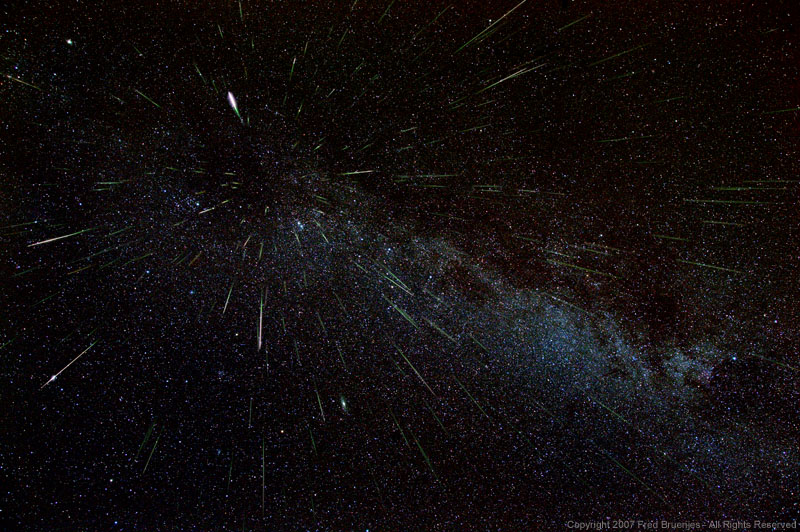

| Visitors Now: | |
| Total Visits: | |
| Total Stories: |

| Story Views | |
| Now: | |
| Last Hour: | |
| Last 24 Hours: | |
| Total: | |
The Annual Perseid Meteor Shower is Coming Up
read more at Anne’s Astronomy News http://annesastronomynews.com/
The annual Perseid meteor shower, which will peak on Aug. 11-12, is one of the most popular every year because it happens on warm summer nights, when gazing at the starry sky is always enjoyable. In a clear, dark sky there may be as many as 60 bright meteors per hour, some with smoke trails that last several seconds after the meteor has vanished. Start observing around midnight local daylight time. A crescent moon will rise around 1 a.m., but it won’t have much effect.

A record breaking 253 meteors are included in this composite image of the 2007 Perseid Meteor shower taken during two nights, August 11-13th, over fifteen and a half hours. Image Credit: Fred Bruenjes
The Perseids will be visible for most of August, though there will be fewer meteors to see the further from the peak date you watch. If the peak is hidden by clouds, for example, try looking for meteors again as soon as the night sky is clear. To minimize the effect of local light pollution, which can obscure as many as half of the meteors, try to avoid artificial lights. Face east if you have a clear view in that direction, and look about half way up the sky from the horizon. You won’t need binoculars or a telescope because the meteors move much too fast for those. The chances of seeing a fireball will be greatest near dawn, when Earth will be moving head on into the meteor stream.
The Perseids may appear anywhere in the sky, but they will seem to originate from a point called the radiant in the constellation Perseus, which gives the meteors their name. The higher the radiant is above the northeastern horizon, the more meteors will be visible. Perseus is just north of the W-shaped constellation Cassiopeia in the Milky Way, with the bright star Capella and the Pleiades star cluster below it. Meteors near the radiant will have short trails because we see them nearly end on, while those far from the radiant will look longer because they are seen from the side.

Looking northeast around midnight on August 11th-12th. The red dot is the Perseid radiant. Although Perseid meteors can appear in any part of the sky, all of their tails will point back to the radiant. Image Credit: Spaceweather.com
Most meteor showers happen when Earth crosses the orbit of a comet; the Perseids come from Comet Swift Tuttle. The meteors are caused by particles released from the comet’s nucleus and left behind in space. As Earth plows through this stream of debris, ranging in size from sand grains to pebbles, each particle slams into our atmosphere at a speed of more than 50 kilometers per second and burns up almost instantly from friction with air molecules. The resulting heat momentarily creates a streak of glowing air that we see as a meteor (sometimes called a “shooting star” or “falling star”). All of this happens about 50 miles (80 kilometers) above the ground, regardless of how close some meteors may appear.
A computer simulation of meteors streaking from the Perseid shower’s radiant can be seen at www.shadowandsubstance.com/.
Source: Indiana University
n/a
2012-08-07 09:47:49
Source: http://annesastronomynews.com/the-annual-perseid-meteor-shower-is-coming-up/
Source:


